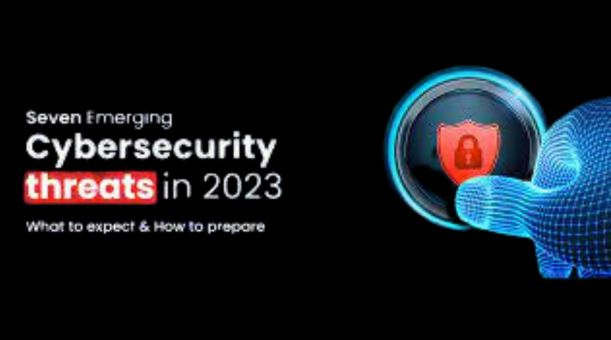Cybersecurity threats have become an increasingly pressing concern in today’s digital age. With the proliferation of technology and the growing dependency on online systems, businesses and individuals face a growing risk of cyber-attacks.
As the threat landscape evolves, staying up-to-date with the latest emerging threats and their potential impact is crucial. In this article, we will survey some of the emerging threats in cybersecurity, explore their potential impact on businesses and individuals, and discuss ways to prepare for and mitigate these risks.
Whether you are an individual user, a small business owner, or part of a large organization, understanding the emerging threats in cybersecurity is essential for protecting your sensitive information and ensuring the security of your digital assets.
A survey of emerging threats in cybersecurity

In 2023, cybersecurity threats will continue evolving and pose significant challenges to businesses and individuals. Here are some of the emerging threats to watch out for:
Artificial Intelligence (AI) attacks:
As AI technology advances, cybercriminals leverage it to launch more sophisticated attacks. For example, attackers can use AI to generate convincing phishing emails or to bypass traditional security systems.
Quantum computing attacks:
Quantum computing has the potential to break many of the cryptographic systems that currently protect our sensitive data. Cybercriminals could leverage quantum computers to easily crack encryption keys, compromising sensitive data.
Ransomware-as-a-service (RaaS):
Ransomware attacks are becoming increasingly prevalent and sophisticated with the emergence of RaaS. This allows even non-technical cybercriminals to purchase pre-built ransomware kits, making it easier than ever to launch an attack.
Internet of Things (IoT) vulnerabilities:
With the proliferation of IoT devices, the attack surface for cybercriminals has increased significantly. Many IoT devices are poorly secured, making them vulnerable to attacks that can compromise the device itself and the entire network it is connected to.
Deepfake attacks:
Deepfake technology allows attackers to create convincing fake images, audio, and video that can be used to deceive people or manipulate public opinion. This can have significant consequences for individuals or organizations that are targeted.
As cybersecurity threats evolve, staying vigilant and taking proactive measures to protect your sensitive data and digital assets is essential. This includes:
- Regularly updating your security systems.
- Implementing strong passwords and two-factor authentication.
- Staying informed about emerging threats.
How has the threat landscape of cybersecurity evolved in recent years?
A Survey Of Emerging Threats In Cybersecurity In 2023 A Survey Of Emerging Threats In Cybersecurity In 2023 A Survey Of Emerging Threats In Cybersecurity In 2023 A Survey Of Emerging Threats In Cybersecurity In 2023 A Survey Of Emerging Threats In Cybersecurity In 2023
The threat landscape of cybersecurity has undergone significant evolution in recent years. Some of the notable changes include:
- Increased sophistication of cyber-attacks
- Greater use of automation
- Expansion of attack surface
- The emergence of nation-state attacks
- Rise of ransomware
- The growing importance of data privacy
These trends have made cybersecurity an increasingly complex and challenging field, requiring organizations and individuals to remain vigilant and proactive in their approach to security. To stay protected, it is crucial to implement a robust security strategy that includes regular risk assessments, employee training, and advanced security tools and technologies.
What are the potential impacts of emerging cybersecurity threats on businesses and individuals?

The potential impacts of emerging cybersecurity threats on businesses and individuals can be severe and far-reaching. For businesses, a cyber-attack can result in data breaches, loss of intellectual property, and significant financial losses. The cost of remediation, damage to reputation, and legal liability can also be substantial. In some cases, cyber-attacks can cause businesses to shut down completely.
For individuals, the impact of a cyber-attack can be just as devastating. Personal data such as social security numbers, credit card information, and login credentials can be stolen, resulting in identity theft and financial fraud. Cybercriminals can also use stolen information to launch phishing attacks, compromising even more sensitive information.
In addition to financial losses, cyber-attacks can have a significant emotional impact on individuals. The loss of personal information can lead to feelings of violation and loss of privacy. In some cases, cyber-attacks can even cause physical harm, such as to medical devices or critical infrastructure.
Overall, the potential impacts of emerging cybersecurity threats on businesses and individuals underscore the importance of protecting sensitive information and digital assets. This includes implementing robust security measures, staying informed about the latest threats, and regularly reviewing and updating security policies and procedures. By taking these steps, businesses and individuals can reduce the risk of falling victim to a cyber-attack and minimize the potential impact of any breaches that do occur.
How can organizations prepare themselves to tackle emerging cybersecurity threats?
Organizations can prepare themselves to tackle emerging cybersecurity threats by taking a proactive approach to security. Here are some key steps they can take:
- Conduct regular risk assessments
- Implement strong security policies
- Use advanced security technologies
- Regularly update software and systems
- Monitor and respond to threats
- Consider outsourcing security
By taking these steps, organizations can better prepare to tackle emerging cybersecurity threats and minimize the risk of a successful cyber attack. It is important to recognize that cybersecurity threats constantly evolve, and organizations must remain vigilant and adapt their security measures accordingly.
What are the common methods used by cybercriminals to exploit emerging cybersecurity vulnerabilities?
Cybercriminals use a variety of methods to exploit emerging cybersecurity vulnerabilities. Here are some of the most common methods:
Phishing: Phishing is a technique in which cybercriminals use fake emails or websites to trick users into providing sensitive information such as usernames, passwords, or credit card numbers.
Malware: Malware refers to malicious software designed to damage, disrupt, or gain unauthorized access to a computer system. Common types of malware include viruses, Trojans, and ransomware.
DDoS attacks: Distributed denial of service (DDoS) attacks are in which cybercriminals flood a website or server with traffic, causing it to become overloaded and unavailable.
Social engineering: Social engineering is a technique in which cybercriminals use psychological manipulation to trick users into divulging sensitive information or performing an action not in their best interest.
Zero-day exploits: Zero-day exploits refer to vulnerabilities in software or hardware that are not yet known to the vendor or developer. Cybercriminals can exploit these vulnerabilities to gain unauthorized access or perform other malicious actions.
Supply chain attacks: Supply chain attacks involve targeting a third-party vendor or supplier to gain access to the target organization’s network or data.
These methods constantly evolve, and cybercriminals always look for new, more sophisticated ways to exploit emerging cybersecurity vulnerabilities. To stay protected, individuals and organizations must stay informed about the latest threats and take proactive measures to mitigate the risk of a successful attack.
How can individuals protect themselves from emerging cybersecurity threats?

Individuals can protect themselves from emerging cybersecurity threats by taking a few simple but important steps:
- Strong passwords are critical to preventing unauthorized access to online accounts. Use a unique, complex password for each account, and consider using a password manager to keep track of them.
- Regularly update software and operating systems to ensure that vulnerabilities are patched, and systems are up-to-date with the latest security features.
- When opening emails, especially those with attachments or links. Verify the sender’s email address and hover over links to verify the URL before clicking.
- Two-factor authentication adds an extra layer of security by requiring a second form of identification, such as a fingerprint or one-time code.
- Antivirus software can help detect and prevent malware infections and other types of cyber-attacks.
- Avoid using public Wi-Fi networks for sensitive activities such as online banking, and use a VPN if you must use public Wi-Fi.
- Stay informed about the latest cybersecurity threats and best practices for staying safe online.
By following these steps, individuals can significantly reduce the risk of falling victim to emerging cybersecurity threats. It is important to remain vigilant and proactively protect sensitive information and digital assets, especially as cyber threats evolve and become more sophisticated.
What role does technology play in mitigating emerging cybersecurity risks?

Here are some ways in which technology can play a role in mitigating emerging cybersecurity risks:
- Artificial intelligence and machine learning algorithms can detect and respond to emerging cyber threats in real-time, enabling organizations to quickly identify and mitigate risks.
- Endpoint security solutions, including antivirus software and firewalls, can help protect individual devices and networks from cyber-attacks.
- Encryption technologies can secure sensitive data in transit and at rest, reducing the risk of unauthorized access or theft.
- Cloud-based security solutions can provide enhanced security features such as continuous monitoring, threat detection, and automated incident response.
- Biometric authentication technologies, such as fingerprint or facial recognition, can help to prevent unauthorized access to sensitive systems or data.
- Security analytics and threat intelligence platforms can provide valuable insights into emerging cyber threats, enabling organizations to mitigate risks before they can be exploited proactively.
- Blockchain technology can create secure, tamper-proof records and transactions, reducing the risk of data breaches or fraudulent activity.
- Zero-trust security architectures, which assume that all access requests are potentially malicious, can help to minimize the risk of cyber-attacks by limiting access to sensitive systems and data.
- By leveraging these technologies, organizations can better protect themselves against emerging cybersecurity risks and stay ahead of the evolving threat landscape.
What are the ethical and legal implications of emerging cybersecurity threats?
Emerging cybersecurity threats have significant ethical and legal implications, including:
Privacy:
Emerging cybersecurity threats can result in the loss of personal and sensitive information, leading to potential violations of privacy and confidentiality. Cybercriminals may steal data such as names, addresses, social security numbers, credit card numbers, or health records, which can be used for identity theft, fraud, or other malicious purposes. This can seriously affect individuals and organizations and even result in legal action.
Liability:
Organizations can be liable for damages from cyber-attacks, especially if they have been negligent in protecting sensitive information or systems. For example, if a healthcare organization is hacked and patient data is exposed, the organization may be held liable for any harm caused to patients due to the breach.
Compliance:
Organizations that handle sensitive information, such as healthcare providers or financial institutions, are subject to numerous legal and regulatory data security and privacy requirements. Failure to comply with these requirements can result in legal and financial penalties. For example, under the General Data Protection Regulation (GDPR) in the European Union, organizations can be fined up to 4% of their annual global revenue for data breaches.
Trust:
Cyber-attacks can erode trust in institutions and organizations, leading to reputational damage and a loss of business or customers. When individuals or organizations have their personal information stolen or compromised, they may lose trust in the organization that failed to protect their information.
Cyber warfare:
Emerging cybersecurity threats can have significant national security implications, including the potential for cyber warfare or cyber terrorism. Cyber-attacks on critical infrastructure, such as power grids or water treatment facilities, can seriously affect public safety and national security.
Ethical considerations:
There are ethical considerations related to using cybersecurity technologies and techniques, such as zero-day exploits or other offensive tactics. Organizations and individuals must consider the potential ethical implications of their cybersecurity practices, such as the potential harm caused by using certain tactics or the potential for unintended consequences.
Conclusion
Emerging cybersecurity threats pose significant risks to organizations and individuals, including the loss of sensitive information, legal and financial penalties, reputational damage, and national security implications. Proactive cybersecurity measures and responsible practices are essential to prepare for these threats. By staying informed and taking steps to protect against emerging cybersecurity threats, we can help mitigate the potential risks and consequences of cyber-attacks.




